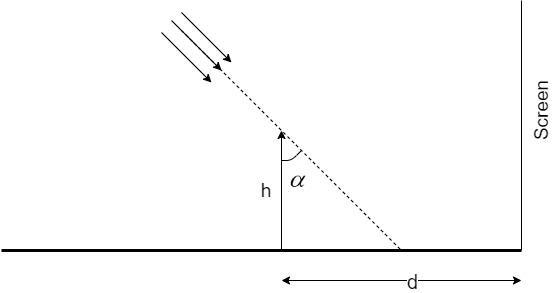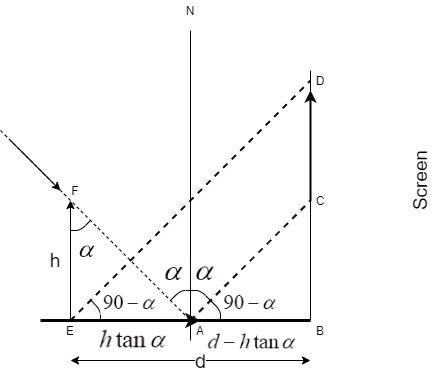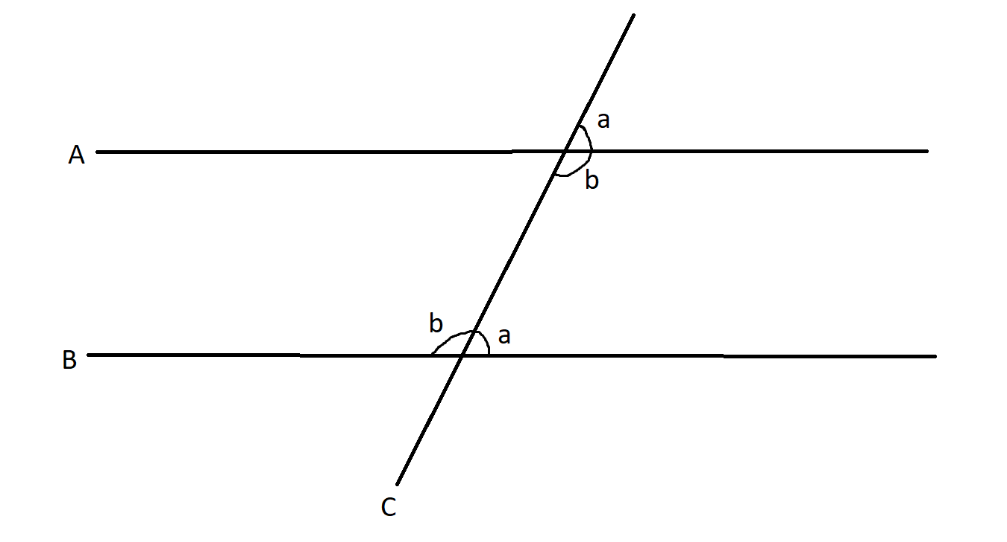
A long horizontal mirror is next to a vertical screen (see figure). Parallel light rays are falling on the mirror at an angle $\alpha $ from the vertical. If a vertical object of height h is kept on the mirror at a distance $d > h\tan \alpha $, the length of the shadow of the object on the screen would be.

A. $\dfrac{h}{2}$
B. $h\tan \alpha $
C. $h$
D. $4h$
Answer
218.4k+ views
Hint: To solve this problem, we have to understand two important concepts and apply them in our problem:
i) Law of reflection: The incident angle is equal to the reflected angle.
$\angle i = \angle r$
ii) The trigonometric ratio, $\tan \theta $ is the ratio of the opposite side of the angle and its adjacent side. $\tan \theta = \dfrac{{Opposite}}{{Adjacent}}$
Complete step by step answer:
The law of reflection states that the incident angle is equal to the reflected angle.
The object of height h is placed on the mirror. The shadow of the object falls on the mirror and the same shadow is reflected back on the screen
The corresponding geometry for the same is given in this figure:

Let us understand the formation of the above geometry in detail.
When the object shadow falls on the mirror at the points A and E, it undergoes a reflection on the plane mirror and an image CD is formed on the screen.
At point A, we have a normal N. The angle made by the ray FA is equal to $\alpha $ since the lines EE and AN are parallel lines and AF is the transverse line, which makes the angles AFE and FAN alternate angles which are equal.
At point A, the incident angle is equal to $\alpha $. Hence, the reflection angle NAD should also be equal to $\alpha $ by the law of the reflection.
Since N is the normal, the angle NAB being equal to 90, the angle CAB = $90 - \alpha $
Since AC is parallel to ED, $\angle DEB = \angle CAB = 90 - \alpha \because $ corresponding angles.
In the triangle AEF,
$\tan \alpha = \dfrac{{Opposite}}{{Adjacent}} = \dfrac{{AE}}{{EF}} = \dfrac{{AE}}{h}$
Thus, $AE = h\tan \alpha $
Given that, AE + AB = d
$AB = d - AE = d - h\tan \alpha $
To calculate the length of the shadow, we need to consider two triangles ABC and EBD to calculate the value of the length CD which is our required value.
In triangle ABC,
$\tan \left( {90 - \alpha } \right) = \dfrac{{BC}}{{AB}} = \dfrac{{BC}}{{d - h\tan \alpha }}$
The trigonometrical identity equal to $\tan \left( {90 - \theta } \right)$ is equal to another identity called $\cot \theta $, where –
$\cot \theta = \dfrac{1}{{\tan \theta }}$
Hence,
$\cot \alpha = \dfrac{{BC}}{{d - h\tan \alpha }}$
In triangle EBD,
$\tan \left( {90 - \alpha } \right) = \dfrac{{BD}}{{EB}} = \dfrac{{BD}}{d}$
The trigonometrical identity equal to $\tan \left( {90 - \theta } \right)$ is equal to another identity called $\cot \theta $, where –
$\cot \theta = \dfrac{1}{{\tan \theta }}$
Hence,
$\cot \alpha = \dfrac{{BD}}{d}$
By equating the values of $\cot \alpha $ in the above triangles,
$\dfrac{{BC}}{{d - h\tan \alpha }} = \dfrac{{BD}}{d}$
$ \Rightarrow BC \times d = BD \times \left( {d - h\tan \alpha } \right)$
$ \Rightarrow BC \times d = BD \times d - BD \times h\tan \alpha $
$ \Rightarrow BD \times h\tan \alpha = d\left( {BD - BC} \right)$
The required length, $CD = BD - BC$
Substituting the value of CD and the value of $BC = \left( {d - h\tan \alpha } \right)\left( {\cot \alpha } \right)$, we get –
$\left( {CD + BC} \right)h\tan \alpha = d \times CD$
$\left( {CD + \cot \alpha \left( {d - h\tan \alpha } \right)} \right)h\tan \alpha = d \times CD$
$ \Rightarrow CD\left( {h\tan \alpha } \right) + h\cot \alpha \tan \alpha \left( {d - h\tan \alpha } \right) = d \times CD$
Since $\cot \alpha = \dfrac{1}{{\tan \alpha }}$
$\cot \alpha \tan \alpha = 1$
Thus,
$ \Rightarrow CD\left( {h\tan \alpha } \right) + h\left( {d - h\tan \alpha } \right) = d \times CD$
$ \Rightarrow CD\left( {h\tan \alpha - d} \right) = h\left( {h\tan \alpha - d} \right)$
$ \Rightarrow CD = \dfrac{{h\left( {h\tan \alpha - d} \right)}}{{\left( {h\tan \alpha - d} \right)}} = h$
Hence, the length of the shadow on the screen, CD = h
Hence, the correct option is Option C.
Note: In this answer, the concept of alternate and corresponding angles are directly applied here. Let us briefly understand them.

A and B are two parallel lines and the line C which intercepts them at an angle is called the transverse line. When a transverse line intercepts the parallel lines, we get several sets of angles.
Here, angles a are called corresponding angle pair and angles b are called alternate angle pair. The relation between them is $a + b = {180^ \circ }$
ii) The trigonometric ratio, $\tan \theta $ is the ratio of the opposite side of the angle and its adjacent side. $\tan \theta = \dfrac{{Opposite}}{{Adjacent}}$
Complete step by step answer:
The law of reflection states that the incident angle is equal to the reflected angle.
The object of height h is placed on the mirror. The shadow of the object falls on the mirror and the same shadow is reflected back on the screen
The corresponding geometry for the same is given in this figure:

Let us understand the formation of the above geometry in detail.
When the object shadow falls on the mirror at the points A and E, it undergoes a reflection on the plane mirror and an image CD is formed on the screen.
At point A, we have a normal N. The angle made by the ray FA is equal to $\alpha $ since the lines EE and AN are parallel lines and AF is the transverse line, which makes the angles AFE and FAN alternate angles which are equal.
At point A, the incident angle is equal to $\alpha $. Hence, the reflection angle NAD should also be equal to $\alpha $ by the law of the reflection.
Since N is the normal, the angle NAB being equal to 90, the angle CAB = $90 - \alpha $
Since AC is parallel to ED, $\angle DEB = \angle CAB = 90 - \alpha \because $ corresponding angles.
In the triangle AEF,
$\tan \alpha = \dfrac{{Opposite}}{{Adjacent}} = \dfrac{{AE}}{{EF}} = \dfrac{{AE}}{h}$
Thus, $AE = h\tan \alpha $
Given that, AE + AB = d
$AB = d - AE = d - h\tan \alpha $
To calculate the length of the shadow, we need to consider two triangles ABC and EBD to calculate the value of the length CD which is our required value.
In triangle ABC,
$\tan \left( {90 - \alpha } \right) = \dfrac{{BC}}{{AB}} = \dfrac{{BC}}{{d - h\tan \alpha }}$
The trigonometrical identity equal to $\tan \left( {90 - \theta } \right)$ is equal to another identity called $\cot \theta $, where –
$\cot \theta = \dfrac{1}{{\tan \theta }}$
Hence,
$\cot \alpha = \dfrac{{BC}}{{d - h\tan \alpha }}$
In triangle EBD,
$\tan \left( {90 - \alpha } \right) = \dfrac{{BD}}{{EB}} = \dfrac{{BD}}{d}$
The trigonometrical identity equal to $\tan \left( {90 - \theta } \right)$ is equal to another identity called $\cot \theta $, where –
$\cot \theta = \dfrac{1}{{\tan \theta }}$
Hence,
$\cot \alpha = \dfrac{{BD}}{d}$
By equating the values of $\cot \alpha $ in the above triangles,
$\dfrac{{BC}}{{d - h\tan \alpha }} = \dfrac{{BD}}{d}$
$ \Rightarrow BC \times d = BD \times \left( {d - h\tan \alpha } \right)$
$ \Rightarrow BC \times d = BD \times d - BD \times h\tan \alpha $
$ \Rightarrow BD \times h\tan \alpha = d\left( {BD - BC} \right)$
The required length, $CD = BD - BC$
Substituting the value of CD and the value of $BC = \left( {d - h\tan \alpha } \right)\left( {\cot \alpha } \right)$, we get –
$\left( {CD + BC} \right)h\tan \alpha = d \times CD$
$\left( {CD + \cot \alpha \left( {d - h\tan \alpha } \right)} \right)h\tan \alpha = d \times CD$
$ \Rightarrow CD\left( {h\tan \alpha } \right) + h\cot \alpha \tan \alpha \left( {d - h\tan \alpha } \right) = d \times CD$
Since $\cot \alpha = \dfrac{1}{{\tan \alpha }}$
$\cot \alpha \tan \alpha = 1$
Thus,
$ \Rightarrow CD\left( {h\tan \alpha } \right) + h\left( {d - h\tan \alpha } \right) = d \times CD$
$ \Rightarrow CD\left( {h\tan \alpha - d} \right) = h\left( {h\tan \alpha - d} \right)$
$ \Rightarrow CD = \dfrac{{h\left( {h\tan \alpha - d} \right)}}{{\left( {h\tan \alpha - d} \right)}} = h$
Hence, the length of the shadow on the screen, CD = h
Hence, the correct option is Option C.
Note: In this answer, the concept of alternate and corresponding angles are directly applied here. Let us briefly understand them.

A and B are two parallel lines and the line C which intercepts them at an angle is called the transverse line. When a transverse line intercepts the parallel lines, we get several sets of angles.
Here, angles a are called corresponding angle pair and angles b are called alternate angle pair. The relation between them is $a + b = {180^ \circ }$
Recently Updated Pages
Young’s Double Slit Experiment Derivation Explained

Wheatstone Bridge Explained: Working, Formula & Uses

Chemical Properties of Hydrogen - Important Concepts for JEE Exam Preparation

JEE General Topics in Chemistry Important Concepts and Tips

JEE Atomic Structure and Chemical Bonding important Concepts and Tips

JEE Amino Acids and Peptides Important Concepts and Tips for Exam Preparation

Trending doubts
JEE Main 2026: Application Form Open, Exam Dates, Syllabus, Eligibility & Question Papers

Derivation of Equation of Trajectory Explained for Students

Hybridisation in Chemistry – Concept, Types & Applications

Understanding the Angle of Deviation in a Prism

Understanding Collisions: Types and Examples for Students

Understanding Atomic Structure for Beginners

Other Pages
JEE Advanced Marks vs Ranks 2025: Understanding Category-wise Qualifying Marks and Previous Year Cut-offs

How to Convert a Galvanometer into an Ammeter or Voltmeter

Understanding Centrifugal Force in Physics

Ideal and Non-Ideal Solutions Explained for Class 12 Chemistry

Degree of Dissociation: Meaning, Formula, Calculation & Uses

Understanding Electromagnetic Waves and Their Importance




